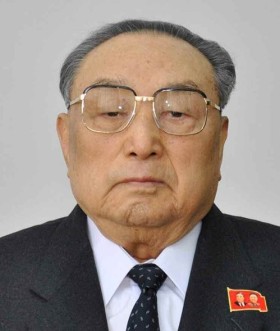Kim Yong-ju facts for kids
Quick facts for kids
Hero of the Republic
Kim Yong-ju
|
|
|---|---|
| 김영주 | |

Kim Yong-ju in 2014
|
|
| Honorary Vice President of the Presidium of the Supreme People's Assembly | |
| In office September 1998 – December 2021 |
|
| President | Kim Yong-nam Choe Ryong-hae |
| Vice President of North Korea | |
| In office December 1993 – October 1997 Serving with Pak Song-chol, Ri Jong-ok, and Kim Pyong-sik
|
|
| President | Kim Il-sung |
| Vice Premier of North Korea | |
| In office 1974–1975 |
|
| Premier | Kim Il |
| Head of the Organization and Guidance Department | |
| In office 1959–1974 |
|
| Leader | Kim Il-sung |
| Preceded by | Pak Yong-bin |
| Succeeded by | Kim Jong-il |
| Personal details | |
| Born | 1920 Taedong County, South Pyongan Province, Japanese Korea |
| Died | December 14, 2021 (aged 101) Pyongyang, North Korea |
| Political party | Workers' Party of Korea |
| Children | 2 biological and 2 adopted |
| Parents | Kim Hyong-jik Kang Pan-sok |
| Relatives | Kim family |
| Alma mater | Moscow State University |
| Korean name | |
| Chosŏn'gŭl |
김영주
|
| Hancha |
金英柱
|
| Revised Romanization | Gim Yeongju |
| McCune–Reischauer | Kim Yŏngchu |
Kim Yong-ju (Korean: 김영주; 1920 – 14 December 2021) was an important politician in North Korea. He was the younger brother of Kim Il-sung, who led North Korea from 1948 to 1994. Kim Yong-ju held many important jobs in the government. He was a member of the Politburo during the 1960s and early 1970s. Later, he lost his powerful position in 1974. This happened after a disagreement with Kim Jong-il, Kim Il-sung's son. From 1998 until he died in 2021, he had a special role. He was the Honorary Vice President of the Presidium of the Supreme People's Assembly (SPA). The SPA is like North Korea's parliament.
Contents
Kim Yong-ju's Early Life and Education
Kim Yong-ju was born in 1920 in Taedong County. His parents were Kim Hyong-jik and Kang Pan-sok. His older brother, Kim Il-sung, was born eight years before him. When Kim Yong-ju was three, his family moved to southern Manchuria.
After finishing school, Kim Yong-ju went to Moscow State University. He studied economics there and also became very interested in philosophy. He graduated in 1945. After university, he joined the Workers' Party of Korea.
Rising Through the Political Ranks
Kim Yong-ju quickly moved up in the Workers' Party of Korea. In the 1950s and 1960s, he held several key positions. He started as a chief leader in 1954. Then he became a vice-director in 1957. By 1960, he was the director of the party's Organization and Guidance Department.
In 1961, he became a member of the WPK Central Committee. This happened at the party's 4th Congress. In 1966, he was promoted again. He became the Organizing Secretary of the WPK Central Committee.
Developing Key Ideologies
In 1967, Kim Yong-ju suggested an important idea to his brother. It was called the "Ten Principles for the Establishment of the One-Ideology System." These principles were about making sure everyone in society followed the ideas of Kim Il-sung. The first principle said that everyone should work to unite society with Kim Il-sung's revolutionary ideas. These principles were officially published in 1974.
Negotiations for Korean Reunification
In 1972, Kim Yong-ju played a big role in secret talks. He represented North Korea in discussions with Pak Chung-hee's government in South Korea. These talks were about bringing North and South Korea back together. The discussions led to an agreement called the July 4th North–South Korea Joint Statement. Kim Yong-ju and South Korea's representative, Lee Hu-rak, signed it. This statement set up conditions for a possible Korean reunification.
Political Challenges and Later Life
By 1970, many people thought Kim Yong-ju would take over from his brother, Kim Il-sung. He was elected as a member of the WPK Politburo. He also joined the top Central People's Committee and the SPA Presidium in 1972.
However, around the same time, Kim Il-sung started preparing his own son, Kim Jong-il, to be the next leader. This led to a disagreement over who would be in charge.
Differences in Political Views
During this time, the Workers' Party of Korea was focusing on Kim Il-sung's Juche idea. This idea was about North Korea being self-reliant. Kim Jong-il strongly supported Juche. But Kim Yong-ju had studied in the Soviet Union. He preferred a more traditional view of Marxism. He was not as keen on the very strong focus on Kim Il-sung's personality. This difference helped Kim Jong-il. Kim Yong-ju slowly lost his influence. His close supporters were removed from their jobs. Eventually, Kim Il-sung himself criticized Kim Yong-ju.
After a meeting of the Central Committee in February 1974, Kim Jong-il was chosen as the future leader. Kim Yong-ju's role was reduced. He became a vice-premier, which was a less powerful position.
Return to Public Life
Kim Yong-ju was not seen in public for a long time. Then, in 1993, Kim Il-sung called him back to Pyongyang. He served as one of North Korea's vice presidents. This was mostly a special, honorary position with no real power. In 1998, he was appointed Honorary Vice-President of the Presidium of the Supreme People's Assembly.
He received important awards for his service. In 2012, he was given the Order of Kim Jong-il. He also received the Order of Kim Il-sung and the title Hero of the Republic. Kim Yong-ju passed away in Pyongyang at the age of 101. North Korean state media announced his death on December 15, 2021.
See also
- North Korean defector in South Korea
- The Mother of Pyongyang
- In Spanish: Kim Yong-ju para niños
|
||||||||||||||||||||||||||||||||||||||||||||||||||||||||||||||||||||||||||||||||||||||||||||||||||||||||||||||||||||||||||||||||||||||||||||||||||||||||||||||||||||||||||||||||||||||||||||||||||||||||||||||||||||||||||||||||||||||||||||||||||||||||||||||||||||||||||||||||||||||||||||||||||||||||||||||||||||||||||||||||||||||||||||||||||||||||||||||||||||||||||||||||||||||||||||||||||||||||||||||||||||||||||||||||||||||||||||||||||||||||||||||||||||||||||||||||||||||||||||||||||||||||||||||||||||||||||||||||||||||||||||||||||||||||||||||||||||||||||||||||||||||||||||||||||||||||||||||||||||||||||||||||||||||||||||||||||||||||||||||||||||||||||||||||||||||||||||||||||||||||||||||||||||||||||||||||||||||||||||||||||||||||||||||
| Notes: | ||||||||||||||||||||||||||||||||||||||||||||||||||||||||||||||||||||||||||||||||||||||||||||||||||||||||||||||||||||||||||||||||||||||||||||||||||||||||||||||||||||||||||||||||||||||||||||||||||||||||||||||||||||||||||||||||||||||||||||||||||||||||||||||||||||||||||||||||||||||||||||||||||||||||||||||||||||||||||||||||||||||||||||||||||||||||||||||||||||||||||||||||||||||||||||||||||||||||||||||||||||||||||||||||||||||||||||||||||||||||||||||||||||||||||||||||||||||||||||||||||||||||||||||||||||||||||||||||||||||||||||||||||||||||||||||||||||||||||||||||||||||||||||||||||||||||||||||||||||||||||||||||||||||||||||||||||||||||||||||||||||||||||||||||||||||||||||||||||||||||||||||||||||||||||||||||||||||||||||||||||||||||||||||

